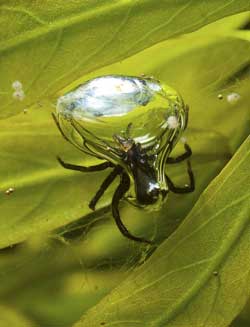The diving bell and the water spider: How spiders breathe under water

Argyroneta aquatica<br>Foto: Stefan K. Hetz
Gazing into the depths of a pond, it's hard to miss the insects that whirl and zip beneath the surface. However, only one species of spider has joined them: the diving bell spider, Argyroneta aquatica. 'It is an iconic animal; I had read about the spider as a small boy in popular literature about ponds,' says Roger Seymour from the University of Adelaide. According to Seymour, each spider constructs a net of silk in vegetation beneath the surface and fills it with air carried down on its abdomen.
The spiders spend their entire lives submerged and even lay their eggs in their diving bells. Having already used an oxygen-measuring device called an optode to discover how aquatic insects extract oxygen from water through thin bubbles of air stretched across their abdomens, Seymour was looking for other small bubbles to test his optode.
'The famous water spider came to mind,' remembers Seymour, and when he mentioned the possibility to Stefan Hetz from Humboldt University, Germany, Hetz jumped at the idea. Inviting Seymour to his lab, the duo decided to collect some of the arachnids to find out how they use their diving bells. The duo report their discovery that the spiders can use the diving bell like a gill to extract oxygen from water to remain hidden beneath the surface in The Journal of Experimental Biology at http://jeb.biologists.org/content/214/13/2175.abstract
Sadly, diving bell spiders are becoming increasingly rare in Europe; however, after obtaining a permit to collect the elusive animals, the duo eventually struck lucky in the Eider River. 'My philosophy is to make some measurements and be amazed because if you observe nature it tells you much more than you could have imagined,' says Seymour. So, returning to the lab, the team reproduced the conditions in a warm stagnant weedy pond on a hot summer's day to find out how the spiders fare in the most challenging of conditions.
After watching the spiders build their shimmering diving bells, the duo gingerly poked an oxygen sensing optode into the bubble to see how the animal reacted. Miraculously, the spider was unperturbed, so they continued recording the oxygen level. 'Then it occurred to me that we could use the bubble as a respirometer,' says Seymour, to find out how much oxygen the spiders consume.
Taking a series of oxygen measurements in the bubble and surrounding water, the team calculated the amount of oxygen flowing into the bubble before calculating the spider's oxygen consumption rate and found that the diving bell could extract oxygen from the most stagnant water even on a hot day. Also, the metabolic rate of the aquatic spider was low and similar to the low metabolic rates of other spiders that sit waiting for prey to pass.
However, despite satisfying the spider's oxygen demands, the bubble continually shrinks because nitrogen diffuses back into the water, eventually forcing the occupant to venture to the surface to resupply the diving bell. So how long could the bubble survive before the spider had to dash up for air? Calculating the diffusion rate of nitrogen out of the bubble, Seymour and Hetz were surprised to find that the spiders could sit tight for more than a day. 'The previous literature suggested they had to come to the surface as often as every 20min throughout the day,' comments Seymour, who adds, 'It is advantageous for the spiders to stay still for so long without having to go to the surface to renew the bubble, not only to protect themselves from predation but also so they don't alert potential prey that come near.'
REFERENCE: Seymour, R. S. and Hetz, S. K. (2011). The diving bell and the spider: the physical gill of Argyroneta aquatica. J. Exp. Biol. 214, 2175-2181.
Media Contact
More Information:
http://jeb.biologists.orgAll latest news from the category: Life Sciences and Chemistry
Articles and reports from the Life Sciences and chemistry area deal with applied and basic research into modern biology, chemistry and human medicine.
Valuable information can be found on a range of life sciences fields including bacteriology, biochemistry, bionics, bioinformatics, biophysics, biotechnology, genetics, geobotany, human biology, marine biology, microbiology, molecular biology, cellular biology, zoology, bioinorganic chemistry, microchemistry and environmental chemistry.
Newest articles

A universal framework for spatial biology
SpatialData is a freely accessible tool to unify and integrate data from different omics technologies accounting for spatial information, which can provide holistic insights into health and disease. Biological processes…

How complex biological processes arise
A $20 million grant from the U.S. National Science Foundation (NSF) will support the establishment and operation of the National Synthesis Center for Emergence in the Molecular and Cellular Sciences (NCEMS) at…

Airborne single-photon lidar system achieves high-resolution 3D imaging
Compact, low-power system opens doors for photon-efficient drone and satellite-based environmental monitoring and mapping. Researchers have developed a compact and lightweight single-photon airborne lidar system that can acquire high-resolution 3D…





















